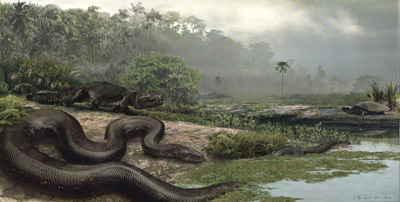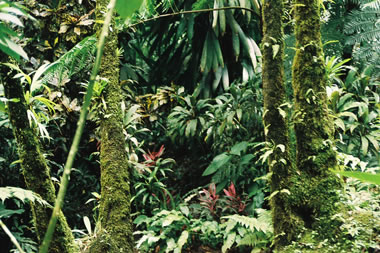Click on image for full size
Courtesy of Jason Bourque, University of Florida
Prehistoric Fossil Snake is Largest on Record
News story originally written on February 4, 2009
Scientists have recovered fossils from a 60-million-year-old South American snake whose length and weight might make today's anacondas seem like garter snakes.
Named Titanoboa cerrejonensis by its discoverers, the size of the snake's vertebrae suggest it weighed 1,140 kilograms (2,500 pounds) and measured 13 meters (42.7 feet) nose to tail tip.
A paper describing the find appears in this week's issue of the journal Nature.
"At its greatest width, the snake would have come up to about your hips," said geologist David Polly of Indiana University, who identified the position of the fossil vertebrae, which made an estimate possible. "The size is pretty amazing. We went a step further and asked, how warm would the Earth have to be to support a body of this size?"
Smithsonian Tropical Research Institute geologist Carlos Jaramillo and University of Florida vertebrate paleontologist Jonathan Bloch discovered the fossils in the Cerrejon Coal Mine in northern Colombia, and investigated what the snake's environment might have been like.
Paleontologist Jason Head of the University of Toronto, the Nature paper's lead author, made an estimate of Earth's temperature 58 to 60 million years ago in an area encompassed by modern-day Colombia.
"Scientists have long known of a rough correlation between a period or epoch's temperature and the size of its poikilotherms [cold-blooded creatures]," said Paul Filmer, program director in the National Science Foundation (NSF)'s Division of Earth Sciences, which co-funded the research. "As Earth's temperature increases, so does the upper size limit on poikilotherms."
"The anatomy of a species is correlated with its environment on broad scales," Polly said. "If we understand these correlations better, we will know more about how climate change affects species, as well as how we can infer things about past climates from species that lived then."
Head estimated that a snake of Titanoboa's size would have required an average annual temperature of 30 to 34 degrees Celsius (86 to 93 Fahrenheit) to survive. By comparison, the average yearly temperature of today's Cartagena, a Colombian coastal city, is about 83 degrees Fahrenheit.
"Tropical ecosystems of South America were surprisingly different 60 million years ago," said Bloch. "It was a rainforest, like today, but it was even hotter and the cold-blooded reptiles were substantially larger. The result was, among other things, the largest snakes the world has ever seen."
The tropical rainforest at Cerrejon appears to have thrived at a temperature of 32 degrees Celsius, five degrees warmer than the upper temperature limit for tropical rainforests in modern times.
"These data challenge the view that tropical vegetation lives near its climatic optimum, and has profound implications for understanding the effect of current global warming on tropical plants," said Jaramillo.
Evolution has produced a variety of gigantic animals over the last several hundred million years--dinosaurs, ancient dragonflies and today's blue whale, to name a few. Why some species' lineages produce monsters remains a matter of debate among evolutionary biologists and ecologists.
The scientists classify Titanoboa as a boine snake, a type of non-venomous constrictor that includes anacondas and boas.
Polly extrapolated the placement of Titanoboa fossil vertebrae by comparing the fossils' structure to the vertebrae of today's boine snakes.
Snake vertebrae become larger near a snake's midsection, but they are also structured differently than vertebrae closer to a snake's head or tail.
Using a computer model, Polly estimated that the fossil vertebrae originated near Titanoboa's middle. Therefore, the snake could have been even larger than it appears.
Also contributing to the Nature report were Alexander Hastings, Jason Bourque, Fabiany Herrera and Edwin Cadena of the University of Florida.
The project was co-funded by the Smithsonian Institution, Carbones del Cerrejon LLC (Colombia), Geological Society of America, Florida Museum of Natural History, University of Florida, University of London and Indiana University.
Text above is courtesy of the National Science Foundation















